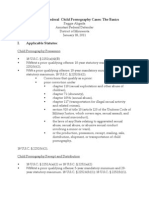Unit-10.-Cattell Eysenck McCrae Costa Trait-Theories
Unit-10.-Cattell Eysenck McCrae Costa Trait-Theories
Uploaded by
hzntrpCopyright:
Available Formats
Unit-10.-Cattell Eysenck McCrae Costa Trait-Theories
Unit-10.-Cattell Eysenck McCrae Costa Trait-Theories
Uploaded by
hzntrpOriginal Title
Copyright
Available Formats
Share this document
Did you find this document useful?
Is this content inappropriate?
Copyright:
Available Formats
Unit-10.-Cattell Eysenck McCrae Costa Trait-Theories
Unit-10.-Cattell Eysenck McCrae Costa Trait-Theories
Uploaded by
hzntrpCopyright:
Available Formats
1|Page
TRAIT THEORIES
Raymond Cattell, Hans Eysenck, and
Robert Mccrae and Paul Costa, Jr.
➢ Trait classification date from the time of the Greek physician Hippocrates (460-377 B.C.)
➢ Hippocrates distinguished four types of people: happy, unhappy, temperamental, and apathetic.
➢ The causes of these different types were internal bodily fluids or “humors”
➢ Sanguine Personality Type -People with a sanguine personality type tend to be lively,
optimistic, buoyant, and carefree. They love adventure and have high risk tolerance.
Sanguine people are typically poor at tolerating boredom and will seek variety and
entertainment. Naturally, this trait can sometimes negatively affect their romantic and
other relationships. Because this temperament is prone to pleasure-seeking behaviors,
many people with sanguine personalities are likely to struggle with addictions. Their
constant cravings can lead to overeating and weight problem.
➢ Phlegmatic Personality Type -Someone with a phlegmatic personality is usually a people
person. They seek interpersonal harmony and close relationships, which makes
phlegmatic people loyal spouses and loving parents. They make it a point to preserve
their relationships with old friends, distant family members, and neighbors. People with
phlegmatic temperaments tend to avoid conflict and always try to mediate between
others to restore peace and harmony.
➢ Choleric Personality Type -Someone with a pure choleric temperament is usually a goal-
oriented person. Choleric people are very savvy, analytical, and logical. Extremely
practical and straightforward, they aren’t necessarily good companions or particularly
friendly. They dislike small talks and enjoy deep and meaningful conversations. They
would rather be alone than in the company of shallow, superficial people.
➢ Melancholic personality type -is considered to be introverted, analytical, logical and
private. He or she relies on facts instead of speculations. This type of person is cautious
and a bit slow when it comes to responding to others because he or she can be skeptical
and suspicious. Not as confident as the individual who has a Choleric Personality Type,
the Melancholic person worries about how other people feels about his or her work. So,
being a perfectionist is one of the traits attributed to this individual. And unlike the
unsympathetic choleric, the Melancholic Personality Type can be moved to tears because
Prepared by: Ms. Laarni D. Muzones, MSPsy PERTHE230 Theories of Personality
2|Page
of compassion for another. Being organized is also common among these types of
people and at times when they seem to have clutter around them, they know where to
find what they need. The Melancholy prefers to get feedback and be reassured. He or she
also wants to be told the reason behind having to do something. This person can also be
fond of asking questions over and over again because of the fear of making the wrong
decisions. That said, this individual is not a risk-taker and does not want to be regarded as
incompetent.
➢ In 1940s, the American physician William Sheldon (1899-1977) offered a personality typology
based on body build.
➢ He proposed three body types, each associated with a different temperament.
➢ Sheldon considers personality traits to be largely fixed.
Similarities & Differences between Cattell and McCrae and Costa’s work
➢ Cattell and McCrae and Costa both used an inductive method of gathering data; that is they
begin with no preconceived bias concerning the number or name of traits or types. Cattell
had only an indirect influence on McCrae and Costa. They did however, share techniques and
ideas, even if their approaches also had some real differences.
➢ Cattell used three different media of observation to examine people from as many angles as
possible. In contrast, each of McCrae and Costa’s five bipolar factors is limited to responses
on questionnaires.
➢ Sources of data used by Cattell:
Prepared by: Ms. Laarni D. Muzones, MSPsy PERTHE230 Theories of Personality
3|Page
➢ L data –a person’s life record derived from observations made by other people
➢ Q data –self-reports obtained from questionnaires and other techniques designed to
allow people to make subjective descriptions of themselves.
➢ T data –objective tests which measures performance such as intelligence, speed of
responding, and other activities designed to challenge people’s maximum
performance
➢ Cattell divided traits into common traits (shared by many) and unique traits (peculiar to one
individual). He also distinguished source traits from trait indicators or surface traits. He
further classified traits into temperament, motivation, and ability. Traits of temperament are
concerned with how a person behaves, motivation deals with why one behaves, and ability
refers to how far or how fast one perform
➢ Cattell’s multifaceted approach yielded 35 primary, or first-order traits, which measure
mostly the temperament dimension of personality.
➢ The largest and most frequently studied of the normal traits are the 16 personality factors
found on Cattell’s Sixteen Personality Factors Questionnaire (16 PF Scale)
➢ By comparison, the NEO-Personality Inventory of Costa and McCrae yields scores on only five
personality factors.
Raymond Cattell
➢ Cattell’s goal in his study of personality was to predict how a person will behave in response to a
given stimulus situation.
➢ Cattell’s theory of personality, then, did not originate in a clinical setting. His approach is
rigorously scientific, relying on observations of behavior and masses of data.
➢ The hallmark of Cattell’s approach was his treatment of the data. He submitted them to the
statistical procedure called factor analysis, which involves assessing the relationship between
each possible pair of measurements taken from a group of subjects to determine common
factors.
➢ Cattell referred to these factors as traits, which he defined as the mental elements of the
personality.
Prepared by: Ms. Laarni D. Muzones, MSPsy PERTHE230 Theories of Personality
4|Page
Cattell’s Sixteen Personality Factors
ROBERT McCRAE AND PAUL COSTA, JR. : THE FIVE-FACTOR MODEL
➢ Working at the Gerontology Research Center of the National Institutes of Health in Baltimore,
Maryland, Robert McCrae (1949–) and Paul Costa (1942–) embarked on an extensive research
program that identified five so-called robust or Big Five factors. These factors are Openness,
Conscientiousness, Extraversion, Agreeableness, and Neuroticism or commonly called as OCEAN.
➢ The factors were confirmed through a variety of assessment techniques including self-ratings,
objective tests, and observers’ reports. The researchers then developed a personality test, the
NEO Personality Inventory, using an acronym derived from the initials of Neuroticism,
Extraversion, and Openness.
➢ McCrae and Costa agreed with Eysenck that personality traits are bipolar and follow a bell-
shaped distribution.
➢ Most people score near the middle of each trait, with only a few people scoring at the extremes.
Prepared by: Ms. Laarni D. Muzones, MSPsy PERTHE230 Theories of Personality
5|Page
• NEUROTICISM
– People who score high on neuroticism tend to be anxious, temperamental, self-
pitying self-conscious, emotional, and vulnerable to stress-related disorders.
– Those who score low are usually calm, even-tempered, self-satisfied, and
unemotional.
• EXTRAVERSION
– People who score high in extraversion tend to be affectionate, jovial, talkative,
joiners, fun-loving.
– In contrast, low scorers are likely to be reserved, quiet, loners, passive, and lacking
the ability to express strong emotion.
• OPENNESS TO EXPERIENCE
– High scorers are creative, imaginative, curious, and liberal and have a preference for
variety.
– Low scorers are typically conventional, down-to-earth, conservative, and lacking in
curiosity.
– People who consistently seek out different and varied experiences would score high
on this factor. They also tend to question traditional values.
– Low scorers will stick to familiar items and one they know they will enjoy. They
support traditional values and gives importance to preserving a fixed style of living.
• Agreeableness
– High scorers tend to be trusting, generous, yielding, acceptant, and good-natured.
– Low scorers are generally suspicious, stingy, unfriendly, irritable, and critical of other
people.
Prepared by: Ms. Laarni D. Muzones, MSPsy PERTHE230 Theories of Personality
6|Page
• Conscientiousness
– High scorers are hardworking, conscientious, punctual, and persevering.
– Low scorers are disorganized, negligent, lazy, and aimless and are likely to give up
when project becomes difficult.
APPLICATIONS OF THE BIG FIVE
Research has been successfully used to predict job performance. Many of the traits reflected
in the Big Five structure are related to those needed for positive achievement in work. For example,
successfully driving a truck requires an individual who is conscientious and emotionally stable; an
impulsive, sociable individual is more likely to cause problems on the road. It is also used in the
diagnosis of personality disorders and determination of therapy.
HANS EYSENCK: Biologically Based Factor Theory
➢ He agreed with Cattell that personality is composed of traits, or factors, derived by the factor-
analytic method.
➢ Although Eysenck used factor analysis to uncover personality traits, he supplemented the
method with personality tests and experimental studies that considered a wide range of
variables.
➢ Eysenck and his wife, Sybil (Ph.D., University of London), together developed many of the
questionnaires used in their research.
➢ The result of their efforts is a personality theory based on three dimensions, defined as
combinations of traits or factors.
➢ All three dimensions are bipolar, with extraversion being at one end of introversion, neuroticism
at one pole and stability at the other, and psychoticism at one pole and superego function at the
other.
➢ Neuroticism and psychoticism are not limited to pathological individuals, although disturbed
individuals tend to score higher than normal people on scales measuring these factors.
➢ Research has shown that the traits and dimensions Eysenck proposed tend to remain stable
throughout the life span despite our different social and environmental experiences. The
situations may change but the dimensions remain consistent.
Prepared by: Ms. Laarni D. Muzones, MSPsy PERTHE230 Theories of Personality
7|Page
THREE DIMENSIONS OF PERSONALITY
1. E –Extraversion versus Introversion
2. N –Neuroticism versus Emotional stability
3. P –Psychoticism versus Impulse Control (or superego functioning)
EXTRAVERSION vs INTROVERSION
Eysenck believed that the principal differences between extraversion and introversion are
not behavioral, but rather biological and genetic in nature.
Extraverts participate more often in exciting and stimulating activities. However, introverts
shun activities such as wild social events and any activities that cause too much excitement.
NEUROTICISM vs STABILITY
People who score high on neuroticism often have a tendency to overreact emotionally and
have difficulty returning to normal state after emotional arousal.
A stable person’s nervous system will generally be less reactive to stressful situations,
remaining calm and level headed
PSYCHOTICISM vs SUPEREGO FUNCTION
People who score high on psychoticism are often egocentric, cold, nonconforming,
impulsive, hostile, aggressive, suspicious, psychopathic, and antisocial.
Low scorers tend to be altruistic, highly socialized, empathic, caring, cooperative,
conforming, and conventional.
Prepared by: Ms. Laarni D. Muzones, MSPsy PERTHE230 Theories of Personality
8|Page
References:
Engler, B. (2012). Theories of Personality. Cengage Learning Asia Pte. Ltd.
Feist J. et. al (2013). Theories of Personality 8th Edition. McGraw-Hill Education.
Schultz & Schultz (2013). Theories of Personality 10th Edition. Cengage Learning
Prepared by: Ms. Laarni D. Muzones, MSPsy PERTHE230 Theories of Personality
You might also like
- Gay Gay FormatDocument7 pagesGay Gay FormatLife Camp Tv83% (6)
- Hatch Battery Market Solutions-BrochureDocument16 pagesHatch Battery Market Solutions-BrochurexianghuaokNo ratings yet
- Educ 109 - The Teaching ProfessionDocument10 pagesEduc 109 - The Teaching ProfessionFegie GemarinoNo ratings yet
- Ellen G. White Writings Comprehensive Research Edition ReadmeDocument5 pagesEllen G. White Writings Comprehensive Research Edition ReadmeAntonioCarlos100% (1)
- OB Section 5 PreviewDocument21 pagesOB Section 5 PreviewhassanmuhammadnaNo ratings yet
- UTS MidtermDocument31 pagesUTS MidtermAltea Shane BalicotNo ratings yet
- OB Assignment PersonalityDocument2 pagesOB Assignment Personalityaysh_345No ratings yet
- Chapter 2 PDFDocument73 pagesChapter 2 PDFPari SharmaNo ratings yet
- Personality: Unit B (Topic 3)Document47 pagesPersonality: Unit B (Topic 3)REHANRAJNo ratings yet
- Lesson 1 Understanding The Self Introduction To Self-UnderstandingDocument5 pagesLesson 1 Understanding The Self Introduction To Self-UnderstandingDiana CaballesNo ratings yet
- UTS ModuleDocument30 pagesUTS ModuleEvangeline HernandezNo ratings yet
- Dispositional TheoriesDocument36 pagesDispositional TheoriesVenci Lizardo PeñaflorNo ratings yet
- Trait TheoryDocument16 pagesTrait TheorySachin KumarNo ratings yet
- Personality Health Wellbeing During Adulthood and AgeingDocument41 pagesPersonality Health Wellbeing During Adulthood and AgeingKarma ProjectNo ratings yet
- Lesson 1 UTSDocument3 pagesLesson 1 UTSElla AlogNo ratings yet
- Personality: I) Heredity: The Genetic Components Inherited From Our Parents at The Time ofDocument7 pagesPersonality: I) Heredity: The Genetic Components Inherited From Our Parents at The Time ofRohan TandonNo ratings yet
- Chapter 6: Personality: Objectives of This ChapterDocument54 pagesChapter 6: Personality: Objectives of This ChaptereyobNo ratings yet
- GED 101 MODULE 1 WEEK 1 MergedDocument36 pagesGED 101 MODULE 1 WEEK 1 MergedMendozaNo ratings yet
- Trait Theory - Group 3Document10 pagesTrait Theory - Group 3anything0.atallNo ratings yet
- PersonalityDocument27 pagesPersonalityArslan KhanNo ratings yet
- Personality Lecture 1 (Autosaved)Document50 pagesPersonality Lecture 1 (Autosaved)ManikyaMayankNo ratings yet
- Week 1 - Understanding The SelfDocument11 pagesWeek 1 - Understanding The SelfGlecy RazNo ratings yet
- The Big Five Personality TraitsDocument8 pagesThe Big Five Personality TraitsNeajNo ratings yet
- Personality - NewDocument42 pagesPersonality - NewJohnson MurrayNo ratings yet
- Personality and ValuesDocument38 pagesPersonality and ValuesRigan paulNo ratings yet
- The Big Five Personality TraitsDocument15 pagesThe Big Five Personality TraitsyohannesNo ratings yet
- GED 101 - Understanding The Self PART IDocument56 pagesGED 101 - Understanding The Self PART Iallenamaearguelles06No ratings yet
- Roll Number:: Umar AliDocument6 pagesRoll Number:: Umar AliDil NawazNo ratings yet
- Personal Development 11Document4 pagesPersonal Development 11dansecoalvinjrNo ratings yet
- SESSION 8 PersonalityDocument57 pagesSESSION 8 PersonalityKainaat YaseenNo ratings yet
- University School of Business Bachelor of Business AdminstrationDocument31 pagesUniversity School of Business Bachelor of Business AdminstrationMesiya Anastasiabarus100% (1)
- Lesson 1 GED101Document8 pagesLesson 1 GED101LOUIS MARKO ARVIE SEMA�ANo ratings yet
- 5 CharacyeridtcsDocument12 pages5 CharacyeridtcsJerry G. GabacNo ratings yet
- Unit V PersonalityDocument24 pagesUnit V Personalitypradeeppatidar655No ratings yet
- Personality A AssignmentDocument12 pagesPersonality A AssignmentSahil MushafNo ratings yet
- Personality Part 3Document35 pagesPersonality Part 3api-343457547No ratings yet
- What Is Personality?Document10 pagesWhat Is Personality?SHREYA GUPTANo ratings yet
- Mpi 2Document7 pagesMpi 2pinkykuku12No ratings yet
- Practical Epq (Eyesenck'S Personality Questionnaire)Document8 pagesPractical Epq (Eyesenck'S Personality Questionnaire)Rivisha SinghNo ratings yet
- The Big 5 Factors or O C E A N Theory of Personality TraitsDocument1 pageThe Big 5 Factors or O C E A N Theory of Personality TraitsSumit GhoshroyNo ratings yet
- Understanding The Self 1st Sem ReviewerDocument26 pagesUnderstanding The Self 1st Sem Reviewerhewiwab718No ratings yet
- Unit 20 LO1Document56 pagesUnit 20 LO1Ryk RamosNo ratings yet
- S The Big Five Personality TestDocument4 pagesS The Big Five Personality TestXiaomi MIX 3No ratings yet
- Summary of TOPDocument10 pagesSummary of TOPathercineNo ratings yet
- Raymond Catell - He Began His Work by Identifying CertainDocument5 pagesRaymond Catell - He Began His Work by Identifying Certainleonida p. barnobalNo ratings yet
- HBO Lesson 6 7Document7 pagesHBO Lesson 6 7Chariz Joice RodriguezNo ratings yet
- Big Five FactorDocument40 pagesBig Five FactorTamo Jit100% (2)
- Trait TheoryDocument2 pagesTrait TheoryKeval King100% (1)
- Chapter 6 PersonalityDocument13 pagesChapter 6 PersonalityeyobgashawNo ratings yet
- Psychology Grand Assignment - Hassan Zeb LLB 4th - 56273Document14 pagesPsychology Grand Assignment - Hassan Zeb LLB 4th - 56273Hassan ZebNo ratings yet
- Additional Chapter - Big Five Personality Traits-The 5-Factor Model of PersonalityDocument9 pagesAdditional Chapter - Big Five Personality Traits-The 5-Factor Model of PersonalityAlya MaisarahNo ratings yet
- Introduction To Personality: Submitted By-Shweta Uppal Saloni Sahu Sanjit MohapatraDocument31 pagesIntroduction To Personality: Submitted By-Shweta Uppal Saloni Sahu Sanjit Mohapatraanshu bhatia57% (7)
- Class XII Chapter 5Document30 pagesClass XII Chapter 5Seerat BindraNo ratings yet
- PersonalityDocument14 pagesPersonalitySoumyalaha18_9997350No ratings yet
- Chapter2 KnowingOneselfDocument4 pagesChapter2 KnowingOneselfJulieta Lumapas OdtojanNo ratings yet
- PERSONALITY - OB NotesDocument6 pagesPERSONALITY - OB NotesPriyamvada ShankarNo ratings yet
- Ged101 Module in UTSDocument53 pagesGed101 Module in UTSAntonnette PagsinohinNo ratings yet
- Big Five Personality TraitsDocument39 pagesBig Five Personality TraitsndmudhosiNo ratings yet
- Per Dev Notes I C2 Knowing OneselfDocument5 pagesPer Dev Notes I C2 Knowing OneselfrnzyrlcasinilloNo ratings yet
- Lecture 3 Personality, 2024Document60 pagesLecture 3 Personality, 2024tetteh godwinNo ratings yet
- Intro, Self - PhilosophyDocument23 pagesIntro, Self - PhilosophyCath FofueNo ratings yet
- Bba IV Bis Unit 3 NotesDocument18 pagesBba IV Bis Unit 3 NotesHarsh ThakurNo ratings yet
- PersonalityDocument13 pagesPersonalityanmolbansal0876No ratings yet
- E1 2-CellsDocument7 pagesE1 2-CellshzntrpNo ratings yet
- E1.1 Introduction To Anatomy and PhysiologyDocument6 pagesE1.1 Introduction To Anatomy and PhysiologyhzntrpNo ratings yet
- E1.3 Body TissuesDocument5 pagesE1.3 Body TissueshzntrpNo ratings yet
- A1.1 Parts of The MicroscopeDocument2 pagesA1.1 Parts of The MicroscopehzntrpNo ratings yet
- E1.2a Cell Cycle and MitosisDocument3 pagesE1.2a Cell Cycle and MitosishzntrpNo ratings yet
- Unit 12. Albert Bandura - Social Learning Theory 1Document6 pagesUnit 12. Albert Bandura - Social Learning Theory 1hzntrpNo ratings yet
- Unit 9. Gordon Allport - Motivation and PersonalityDocument9 pagesUnit 9. Gordon Allport - Motivation and PersonalityhzntrpNo ratings yet
- IGC Document 147-13-E Revision of Doc 147-08-EDocument75 pagesIGC Document 147-13-E Revision of Doc 147-08-Elutfirashid87No ratings yet
- Construction Technology Chapter OneDocument20 pagesConstruction Technology Chapter OneLego EdrisaNo ratings yet
- Limitless Learning AssessingDocument23 pagesLimitless Learning AssessingSushan MaharjanNo ratings yet
- Heartstopper SPANISH Transcript 201 OutDocument52 pagesHeartstopper SPANISH Transcript 201 Outfernanda benilda ramos riosNo ratings yet
- Ejercicios Present TensesDocument4 pagesEjercicios Present TensesAlejandra ÁlvarezNo ratings yet
- Internship Report PresentationDocument17 pagesInternship Report PresentationNikhil BhatNo ratings yet
- 7 Tests That You Need On The Steel StructureDocument6 pages7 Tests That You Need On The Steel StructureBBGNo ratings yet
- Bharti Airtel Limite1 Sales & DistributionDocument22 pagesBharti Airtel Limite1 Sales & DistributionAshwini JhaNo ratings yet
- C-11 - (13th) (POI) Paper 1 SOLUTIONDocument7 pagesC-11 - (13th) (POI) Paper 1 SOLUTIONRaju SinghNo ratings yet
- The Invisible ManDocument129 pagesThe Invisible ManMirela DiaconescuNo ratings yet
- Peperiksaan Sekolah Ketiga Tahun 2013 Bahasa Inggeris (Kertas 1) Tingkatan Peralihan Satu JamDocument6 pagesPeperiksaan Sekolah Ketiga Tahun 2013 Bahasa Inggeris (Kertas 1) Tingkatan Peralihan Satu JamJessie Yong Chui ShanNo ratings yet
- Polycab HT XlpeDocument33 pagesPolycab HT Xlpezafrikhan875No ratings yet
- Defending Child Porn CasesDocument6 pagesDefending Child Porn CasesBrian MartinNo ratings yet
- DL 2291Document2 pagesDL 2291Chetan MruthyunjayaNo ratings yet
- Chapter 1-Conceptual FoundationDocument20 pagesChapter 1-Conceptual FoundationTín Đức ĐoànNo ratings yet
- Steel Panthers - MBT Game GuideDocument205 pagesSteel Panthers - MBT Game GuideSeth VanEyckNo ratings yet
- From Monolithic Systems To Microservices: An Assessment FrameworkDocument12 pagesFrom Monolithic Systems To Microservices: An Assessment FrameworkRizwan AhmedNo ratings yet
- Phandelver and Below The Shattered ObeliskDocument244 pagesPhandelver and Below The Shattered ObeliskLinus JoyeuxNo ratings yet
- Hindustan UnilieverDocument8 pagesHindustan UnilieverTeodoraŞaperaNo ratings yet
- That Palastic Bag Should Be BannedDocument12 pagesThat Palastic Bag Should Be Bannedlili afidaNo ratings yet
- 08 Procedure For Design and Development Preview enDocument4 pages08 Procedure For Design and Development Preview enHadj Ali BoumedieneNo ratings yet
- Newsletter 12th - 18th August 2023Document33 pagesNewsletter 12th - 18th August 2023ashsjkakNo ratings yet
- Direct Instruction Lesson Template 2017 1 - 2Document2 pagesDirect Instruction Lesson Template 2017 1 - 2api-455662270No ratings yet
- Can Could Be Able ToDocument2 pagesCan Could Be Able Toluca314No ratings yet
- Sway With MeDocument10 pagesSway With MeRuth Soto GarciaNo ratings yet
- Good Governance Handbook - HQIPDocument17 pagesGood Governance Handbook - HQIPAnggika Yelzi PratiwiNo ratings yet
































































































